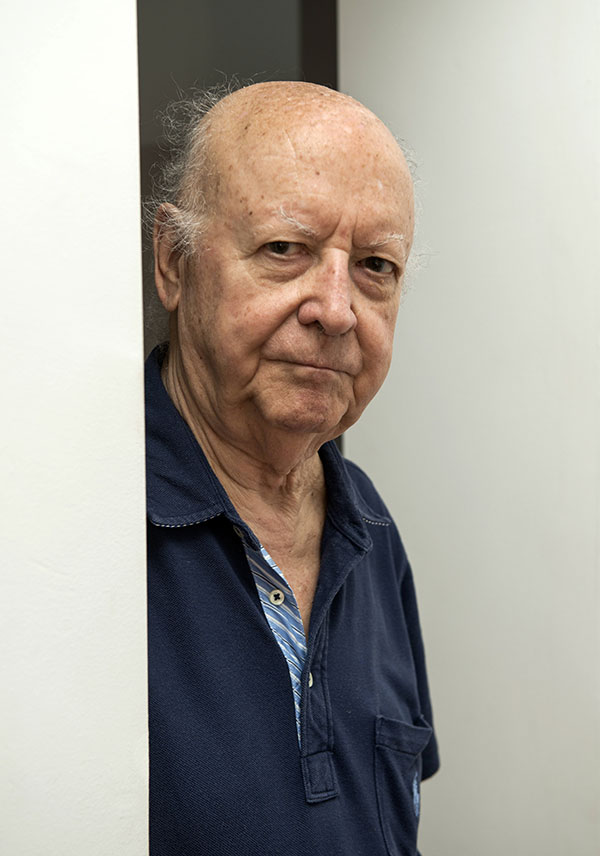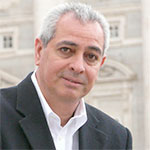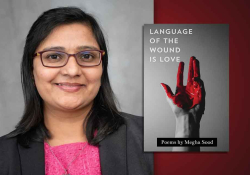A Conversation with Jorge Edwards: Between Fiction and Reality

Jorge Edwards (b. 1931, Santiago de Chile) has had one of the more extensive careers of Latin American writers today. A Chilean diplomat, he has delved into different genres—mainly short fiction, novels, essays, and chronicles—throughout his political career. He has received wide recognition for his literary standing, including the 1994 National Chilean Prize for Literature and the 1999 Spanish Cervantes Prize. His novels, such as El origen del mundo (1996), El inútil de la familia (2004), and, above all, his testimony as diplomat in Cuba, Persona non grata (1973), have brought him wide prestige as a writer and intellectual. His most recent novel, La última hermana (2016), is a lucid reflection about anonymous people who risked their lives during the Occupation of France during World War II in order to fight Nazism. In this case, the protagonist, María Edwards, who was a distant relative of the author’s, was a real person whom Edwards reconstructed based on testimonies, which he then fictionalized with great sobriety as excellent prose.
How did the idea to write La última hermana (The last sister) come about?
We could say it was due to Carlos Morla Lynch, who is well known here [Madrid, where this interview took place], and while he was a Chilean diplomat in this city, he granted asylum to an enormous number of people who were in danger during the civil war. He was a friend of Federico García Lorca. And through Carlos, I met many French Hispanists, who upon hearing my name would ask me if I was related to María Edwards. This happened in the mid-sixties. Until then, I had only heard about her. She was the last sister of the owners of El Mercurio, one of the oldest newspapers in Santiago, and due to personal circumstances, she ended up living in Paris.
What was Paris like during your protagonist María’s time?
It was a frivolous, elegant world, but when World War II began, she decided she didn’t want to play bridge anymore. She wanted to be a social worker and began volunteering in the Rothschild Hospital, which was dangerous, especially for someone like her, because the hospital was run by a Jewish foundation. While I was ambassador to Chile in Paris, I went there and talked to the director. He showed me the maternity ward that is now administrative units. María would hide children under her cape when she went out; but after a while they found out and tortured her; nevertheless, she never deviated from her activity but used extra caution, perhaps.
Was she ever in contact with the children she saved?
In the novel, there was a farewell gathering organized by the children. She corresponded with some of them, but more importantly, through it all she provided support to all of them. And I was able to interview two of them. One was an important violinist, and the other was a tailor on the outskirts of Paris. The description of the frivolity and mundane aspects of Paris is certainly fictionalized, but it was real! María had a great friendship with Jean Cocteau, Colette, Vicente Huidobro, and many other artists and intellectuals who would pay her visits at her house and would attend her parties.
How did this Chilean woman end up in Paris?
Well, the novel contains a large dose of biographical material. She had married a diplomat, Guillermo Errázuriz, who committed suicide in 1922 because he had fallen in love with a North American actress. María remarried, this time to Jacques Feydeau, the son of playwright Georges Feydeau. They separated in 1926, and that’s why she remained in Paris.
She had a close friend there, who plays an important role in the novel, because he was with her wherever she went.
Yes. He was René Núñez Schwartz, a Spaniard of Sephardic origins, who came trying to escape from Spain. He was possibly a Communist. And bisexual. He accompanied her back to Chile from Paris, when she had been ruined; like I said, she had to continue giving money to each child she had saved.
In the novel, María spoke incessantly about a small daughter she had left in Santiago.
That is the curious part, something contradictory, we could say, about María. She had a daughter named Mita, whom she had left in Santiago and, obviously, never saw. She saved the children of others but was unconcerned about her own child.
Another very interesting character is Brunilda, her maid.
She’s fictitious, a typical thing on my part. Not knowing the details of María’s daily life, I invented a character, her maid, who was very Chilean and became her friend. Brunilda knew the driver at the Mexican embassy and ended up marrying him. Many readers comment on that character. Eduardo San José, a professor at the University of Oviedo, believes the essential aspect of the novel isn’t about saving children; it’s a novel about family, with many characters.
There’s another key character, Admiral Canaris, who saved María when she was being tortured.
He’s a well-known person and recognized by historians of the war. He was a German of Greek origin who knew the Hispanic world. As a naval officer, his mission was to watch over and provide assistance to the German communities in southern Chile. And here’s where fiction comes into play: I imagine since the Edwards family was very influential and owned El Mercurio, they knew all about María Edwards.
In the novel, the admiral appears with various names.
The name I use in the novel is real: Wilhelm Canaris. He falsified a Chilean passport using the name Reed Rosas, a Chilean of English origin. Around then, he received orders from the German army to escape from Chile and work as a spy. He crossed the Andes Mountains and made it to Europe. He joined the German forces. Then they accused him of having participated in the assassination of Rosa Luxemburg. After the war, he became a naval attaché in Spain. It is believed he was one of those who warned Francisco Franco not to become involved with Hitler. He always thought Germany was condemned to defeat.
How faithful did you want to be to real history?
One of my problems was to fictionalize the details of the lives of those people who actually existed; for example, the details of Canaris’s house when he was detained by the Gestapo. There was an error in my first version, because I had the anti-Semitism of the Germans in occupied Paris beginning too quickly. Maurizio Serra, a friend and a well-known Italian historian, said to me, “Don’t jump the gun about that part, because the Germans were revealing themselves at a slower pace.” As a result, I reorganized the story and explained that the Hispanic American diplomats went to Vichy and left the consuls in Paris. One of them was Salvador Reyes, a well-known Chilean writer of his time whom I met personally.
When did you realize you had material for a novel?
Most of the things I’ve written like novels have occurred to me by previously knowing about a true story. I had been talking about María for a long time. It was much like how I talked about Joaquín [Joaquín Edwards Bello, the author’s uncle and character in El inútil de la familia], a chronicler with leanings toward anarchism who would appear and disappear.
Similar to other characters of yours, they’re based on real characters and conform to historical reality. Are we talking about fictional biographies?
Not exactly, because I also speculate a lot. I think what I do is a type of hybrid genre that involves fiction and nonfiction. In fact, one time Mario Vargas Llosa told me: “Don’t write as if it’s fiction. Write it like a chronicle.”
As you write, do you experience moments of inhibition with regard to using elements that aren’t real?
I like moving between reality and fiction and vice versa. From the beginning, it’s about conscious practicality. It’s a characteristic of my literary work.
How did your vocation as a writer begin?
The last thing that anyone expected was that I was going to be a poet. I was supposed to be a president, a businessman, a lawyer. But early on I discovered poetry through Professor Eduardo Solar Correa, who had a book about literary meter. And searching for sonnets, I discovered the poets. I became a clandestine poet. I would read verses to my friends at San Ignacio. I knew I wasn’t a good poet, but I had a good ear. At the same time, however, I was intrigued by something going on in different parts of Santiago: storytelling. My mother and grandfather were phenomenal storytellers. And when I began writing stories, I felt like I was accomplishing something, not just an imitation, as in writing poetry. I write stories that happen to me or about those stories that someone tells me.
I was intrigued by something going on in different parts of Santiago: storytelling. My mother and grandfather were phenomenal storytellers. And when I began writing stories, I felt like I was accomplishing something, not just an imitation, as in writing poetry. I write stories that happen to me or about those stories that someone tells me.
Right now you’re editing a novel about a particular period in the life of Pablo Neruda—his time as consul in Burma.
I’ve wanted to write this novel for a long time. I had hoped to capture the love that Josie Bliss represented for him. I actually considered traveling to Burma and Ceylon to track down details. A conversation with a friend pointed me in the right direction: “Don’t go; instead, go to a flea market and look for books about that time period. Remember that Emilio Salgari never left Rome.” And I bought books about those places. Then I reread everything Neruda had written about that time period. Basically, Residence on Earth and everything referring to the Orient: Estravagario, Isla Negra: A Notebook, and his Memoirs. And also whatever else Neruda himself had read back then, such as The Nigger of the “Narcissus,” by Joseph Conrad, My Brother Yves, by Pierre Loti, Somerset Maugham, and an important example of feminism in Burma, since I had made Josie Bliss a feminist before the term existed. And I believe reality coincides with fiction, because this woman was misunderstood, having been a nationalist and a feminist at the same time. Perhaps Aung San Suu Kyi, a Burmese politician, is a remote heir of Josie Bliss.
She certainly affected the young Neruda, because she appears one way or another in his poetry and memoirs.
I saw how she had made such a strong impression on him, as in his poem “El tango del viudo,” and in general her presence in Residence on Earth and Isla Negra: A Notebook. And during those times when he wrote Estravagario, took a trip with Matilde through places that had belonged to the British Empire, and visited Colombo and Rangoon . . . a person recognized him: Ricardo Reyes, the Chilean consul.
This is new fictionalized history.
That’s right. This novel begins when he is named consul. It narrates his time in Burma and Ceylon. And later his return to Chile. But what I narrate in detail is the meeting between Josie Bliss and their definitive separation in Ceylon, as well as some events after that.
Why do you think the figure of Neruda has been written about so much? I’m thinking about books by Antonio Skármeta or Roberto Ampuero.
It’s because Neruda had such a varied life. He began in India, then he became involved in the Spanish Civil War, and he saw the beginning of World War II. Also, he’s a person that is easily fictionalized. In the case of Josie, he always had her present in his poems and memoirs.
Who was Josie Bliss?
She was Burmese and worked for the British administration by day. And by night she had another name, her real name, a Burmese name that Neruda had forgotten. Getting at her story was difficult because there are no portraits of her, just narrative descriptions, allusions.
And, once again, the protagonist of your latest novel is a woman.
I have always been interested in feminine perspectives in narrative literature. Ever since my first stories . . . beginning with a lost girl in the school patio run by nuns in the stories of my first book, El Patio.
Correct. Neruda plays a secondary role in this work. I think I have several women as protagonists in my stories: María Edwards, Josie Bliss, Inés Vargas Elizalde, the protagonist of La mujer imaginaria. What you say is true. I have always been interested in feminine perspectives in narrative literature. Ever since my first stories . . . beginning with a lost girl in the school patio run by nuns in the stories of my first book, El Patio. Why? I don’t think I can say for sure. I’ve read works by writers who describe or invent women, from Shakespeare to Flaubert and Tolstoy, and I’ve read female writers, such as María Luisa Bombal from Chile and Virginia Woolf from England. The practice of assuming the point of view of women forces you to insert yourself, as an outsider, in the Other. It’s a type of interesting and healthy transvestism.
May 2016
Translation from the Spanish
By Dick Gerdes
 Jorge Edwards is a renowned novelist, journalist, and diplomat. A native of Santiago, Chile, he currently resides in Madrid. In 1999 he received the coveted Cervantes Prize for Literature in Spain. His latest novel is La última hermana, published in Spain in 2016.
Jorge Edwards is a renowned novelist, journalist, and diplomat. A native of Santiago, Chile, he currently resides in Madrid. In 1999 he received the coveted Cervantes Prize for Literature in Spain. His latest novel is La última hermana, published in Spain in 2016.

















